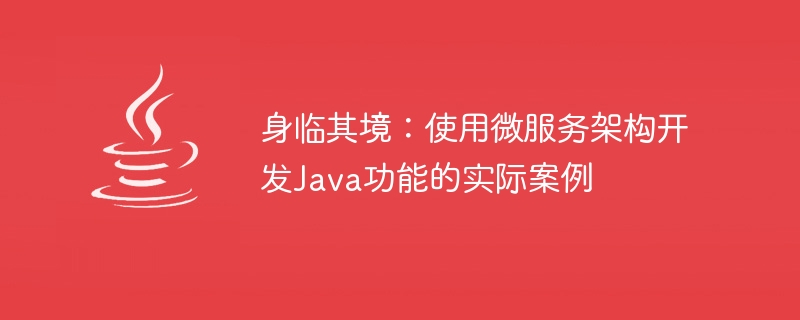Home >Java >javaTutorial >Immersive: Practical examples of using microservice architecture to develop Java functions
Immersive: Practical examples of using microservice architecture to develop Java functions
- 王林Original
- 2023-09-18 11:55:541481browse

Immersive: Practical cases of using microservice architecture to develop Java functions
Introduction
With the rapid development of the Internet, software development has also Facing increasingly complex challenges. In order to cope with this challenge, microservice architecture has gradually become the first choice for building software systems with high scalability, flexibility and maintainability.
This article will use a practical case to show how to use microservice architecture to develop Java functions. We will introduce the concept of microservices and use Spring Cloud as the development framework, showing how to split the application into small, autonomous services and communicate using RESTful APIs.
Introduction to Microservice Architecture
Microservice architecture is an architectural style that splits applications into small, autonomous services. Each service is an independent, independently deployable and scalable unit that interacts through lightweight communication mechanisms. This architecture can bring many benefits, including better flexibility, scalability, and maintainability.
Case Background
Suppose we are developing an online shopping platform. We need to develop the following functions:
- User service: handle user registration, login and manage user information.
- Product service: handles the display, search and management of products.
- Order service: handles user order placement, payment and order processing.
Each function will be split into an independent service and communicate using RESTful API. Now we will detail the development process of each service.
User Service
User Service is responsible for processing user registration, login and management of user information. We will use Spring Boot and Spring Cloud to develop this service.
First, we need to create a new Spring Boot project and add the required dependencies. Then, we can define a UserController class with the following functions:
@RestController
public class UserController {
@Autowired
private UserService userService;
@PostMapping("/register")
public void registerUser(@RequestBody UserDto userDto) {
userService.registerUser(userDto);
}
@PostMapping("/login")
public void loginUser(@RequestBody UserDto userDto) {
userService.loginUser(userDto);
}
@GetMapping("/users/{id}")
public UserDto getUserById(@PathVariable String id) {
return userService.getUserById(id);
}
}Next, we need to write the UserService class to handle user-related business logic. In this service, we will use Spring Data JPA to manage user data.
@Service
public class UserService {
@Autowired
private UserRepository userRepository;
public void registerUser(UserDto userDto) {
User user = new User(userDto);
userRepository.save(user);
}
public void loginUser(UserDto userDto) {
// 验证用户信息并生成登录令牌
}
public UserDto getUserById(String id) {
User user = userRepository.findById(id)
.orElseThrow(() -> new NotFoundException("User not found"));
return new UserDto(user);
}
}Through the above code examples, we can see how the user service uses Spring Boot and Spring Cloud to handle user registration, login and management of user information.
Commodity Service and Order Service
The development process of commodity service and order service is similar to user service. We need to create a separate Spring Boot project and add the necessary dependencies.
For product services, we need to create a ProductController class to handle the display, search and management functions of products.
@RestController
public class ProductController {
@Autowired
private ProductService productService;
@GetMapping("/products/{id}")
public ProductDto getProductById(@PathVariable String id) {
return productService.getProductById(id);
}
@GetMapping("/products")
public List<ProductDto> getProducts() {
return productService.getAllProducts();
}
}The ProductService class in the product service will handle product-related business logic, including obtaining product information from the database and searching for products.
@Service
public class ProductService {
@Autowired
private ProductRepository productRepository;
public ProductDto getProductById(String id) {
Product product = productRepository.findById(id)
.orElseThrow(() -> new NotFoundException("Product not found"));
return new ProductDto(product);
}
public List<ProductDto> getAllProducts() {
List<Product> products = productRepository.findAll();
return products.stream()
.map(ProductDto::new)
.collect(Collectors.toList());
}
}The development process of order service is similar to that of product service. We need to create an OrderController class to handle user ordering, payment and order processing.
@RestController
public class OrderController {
@Autowired
private OrderService orderService;
@PostMapping("/orders")
public void placeOrder(@RequestBody OrderDto orderDto) {
orderService.placeOrder(orderDto);
}
@GetMapping("/orders/{id}")
public OrderDto getOrderById(@PathVariable String id) {
return orderService.getOrderById(id);
}
}The OrderService class in the order service will handle order-related business logic, including creating orders, processing order payments, and obtaining order information.
Summary
This article shows how to use microservice architecture to develop Java functions through a practical case. We use Spring Cloud as the development framework to split the application into small, autonomous services and communicate using RESTful APIs. In this way, we can achieve highly scalable, flexible and maintainable software systems. I hope this article can help you understand the development process of microservice architecture.
The above is the detailed content of Immersive: Practical examples of using microservice architecture to develop Java functions. For more information, please follow other related articles on the PHP Chinese website!

